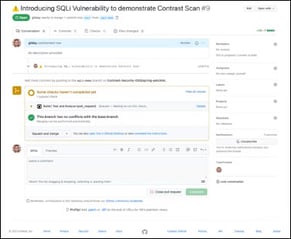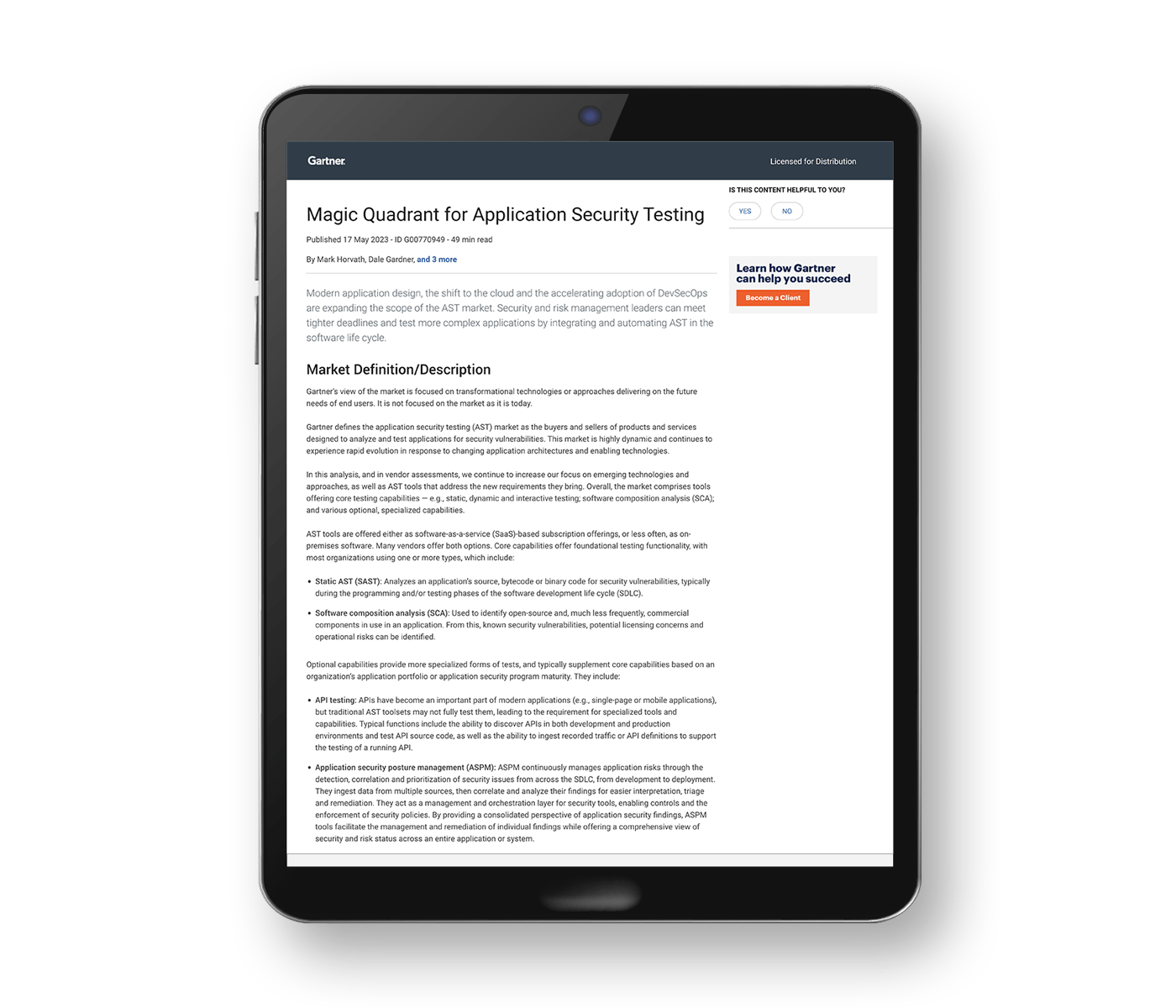EBOOK
How to fix your cybersecurity blindspot
You may not see this gap in your security stack yet, but attackers can. Learn how to close it for good.
Why application security should be a top priority for SOC teams
The past year saw an 180% increase in application exploitation, reflecting either attackers’ growing sophistication or their growing awareness of just how vulnerable applications and APIs can be.1
The Verizon Data Breach Investigations Report (DBIR) estimates:
- 68% of incidents are caused by known software vulnerabilities or internal applications.2
- 78% of cybersecurity professionals reported experiencing an API security incident in the past 12 months.3
As businesses continue to accelerate digital transformation, the complexity of addressing this very real threat in a constantly changing landscape will only increase.
Vulnerability exploitation has increased 180% compared with last year.1
Every application is as unique as a snowflake, written in one of many programming languages. Each uses different libraries and dependencies, and most are built using open-source components — all of which can pose significant security risks. And AI has increased both development speed and number of vulnerabilities.
But most modern security tools don’t focus on what’s happening to those applications. Instead, existing security tools often provide excellent visibility into network traffic, endpoint activity and cloud workloads. Yet they struggle to look into and inside the application layer itself, where many modern attacks originate and unfold. This leaves a critical gap in security defenses, welcoming attackers to access data without raising alarms.
It is time to safeguard applications throughout their entire life cycle — from pre-production to live production environments. While traditional Application Security (AppSec) focuses heavily on preventing vulnerabilities before deployment, the true test lies in protecting code when it’s actively exposed to real-world threats on production servers.
What makes applications so vulnerable?
Security operations centers (SOCs) often have a number of tools in place to protect their environments and infrastructure. However, they typically lack adequate coverage for applications and APIs.
For example, endpoint detection and response (EDR) and cloud detection and response (CDR) solutions are invaluable in the escalating fight against increasingly sophisticated adversaries. However, these tools do not provide comprehensive protection, particularly for applications.
Waiting for an application to be compromised can lead to catastrophic consequences. Speed is critical to detect an attack before it compromises an endpoint or critical data. Adding Contrast Application Detection and Response (ADR) provides otherwise missing visibility into application-level activity, allowing security teams to detect and block attacks before the attacker can create a bad outcome.
This added layer of protection is a powerful safeguard to mitigate breach consequences. Consider this:
- $4.88 million The average cost of a data breach in 2024
- $1.38 million lower The cost of a breach when it is detected early.4
Closing the gaps
How ADR helps two familiar SOC tools to detect application attacks
| WAF | Contrast ADR | |
| Strength | Weakness | Solution |
|
Protects against common web attacks such as distributed denial of service (DDoS) attacks and certain cross-site scripting attacks. Reduces load off your application servers by blocking network traffic of simple and common web application attacks. |
Relies on static signatures or known patterns to identify threats: two methods that sophisticated attackers can evade. High number of false positives or alerts that aren’t clearly actionable. |
Contrast ADR provides deep visibility into the application layer, allowing you to detect and block attacks at their source before they can cause damage or spread throughout your environment. ADR is designed to minimize false positives and provide actionable insights, enabling you to focus on the most critical threats. |
| EDR | Contrast ADR | |
| Strength | Weakness | Solution |
| Monitors and protects endpoints (e.g., desktops, laptops or servers). | No way to know if code inside the application is manipulated. | With deep visibility into application behavior and data flows, your teams can identify anomalies and potential threats that may have bypassed traditional security tools. |
| Detects suspicious activity and investigates incidents at the operating system and network level. | Can miss attacks that occur entirely within the application layer. | ADR real-time threat detection and response capabilities enhance the overall security architecture by providing an additional layer of protection against sophisticated attacks. |
| Provides response capabilities to contain and remediate threats on the operating system level. | SOC may have to wait until an application is compromised before EDR detects the threat. | ADR enhances proactive threat detection capabilities, so you can identify and mitigate application-layer attacks earlier. |
In addition to the finite ability of current tools to protect applications, organizations commonly have limited staff and expertise — or siloed security and development teams. This makes it a struggle to communicate and collaborate, slowing the detection of and response to attacks on the application layer.
Furthermore, teams face the added challenge of being bombarded with alerts that don’t convey enough context to help prioritize the true threats. Because WAFs are limited by their reliance on network traffic analysis, they lack visibility into the application itself. This results in a high number of false positives, creating an overwhelming number of alerts.
Consider that an estimated 26 billion attacks target applications and APIs per month.3 Inevitably, alert fatigue sets in and security teams ignore or tune out potentially important notifications. This creates serious risk for missed threats and delayed incident response.
Bottom line: Sophisticated attackers use novel techniques to evade traditional detection methods, leaving organizations vulnerable to most application-layer attacks and zero days. Without the right people, processes and tools at the ready, it is extremely difficult to keep pace with the evolving threat landscape.
It’s time to secure applications from within
In order to see and stop modern application attacks in time — before the damage is done — security teams need to extend their reach beyond networks and endpoints and into the applications themselves. Contrast ADR eliminates application blindspots and protects applications and APIs by providing unparalleled visibility, accuracy and protection.
How Contrast ADR can help
By operating from within the application, Contrast ADR provides the SOC with the needed visibility to see application attacks in real time, accelerating detection and response to anomalous activity within the application code itself.
Blocking known and unknown vulnerabilities, including zero days, Contrast ADR empowers organizations to stop application threats sooner. This gives the SOC the context it needs to make effective blocking decisions.
Continuous vulnerability assessment and seamless integration with extended detection and response (XDR), plus security information and event management (SIEM) platforms, provide context-rich information about application-level threats. Securing applications from the inside means security teams can effectively detect and respond to attacks in the application layer through actionable, context-rich alerts (not just more noise).
An estimated 26 billion attacks target applications and APIs per month.3
With Contrast ADR, you can:
See application attacks in seconds
- Eliminate application blindspots, giving the SOC real-time visibility.
- Accelerate detection and response to anomalous activity within the application code itself.
Stop zero-day threats
- Block known and unknown vulnerabilities, including many zero days.
- Stop application threats before they cause damage.
- Accelerate response to zero days and custom code vulnerabilities with guided step-by-step runbooks for rapid triage and precise remediation.
Secure with accuracy
- Seamless integration with SOC platforms like security orchestration, automation and response (SOAR) platforms provides context-rich information about application- level threats.
- Actionable alerts help security teams accurately secure their applications
and APIs. - Streamlined incident response and real-time remediation improves compliance while driving collaboration and accountability between the SOC, AppSec and developer teams.
See real risks in real time
A vulnerability in pre-production is a theoretical risk. An exploitable vulnerability in production environments is a real, evidence-based risk that can lead to immediate disruption, data breaches, financial loss and reputational damage.
That is why Contrast Security is dedicated to safeguarding applications throughout their entire life cycle — from
pre-production to live production environments, where your applications are actively exposed to real-world threats.
CASE STUDY
Enhancing AppSec to protect powerful research
A university-based investment management company oversees massive funding sources for medical research, groundbreaking inventions, patents and much more. To support this critical work and over 400,000 students, the company’s IT leadership must ensure secure access to billions of dollars in funding destined for some of the most important research institutions globally, while navigating a rapidly evolving technological landscape.
The company integrated Contrast’s Runtime Security solution directly into their application runtime environments to enable continuous monitoring and immediate threat detection. This strengthens their security profile without slowing down security scanning.
The solution delivered several benefits, including:
- Reduced risk of exploitability: Protection against class-level vulnerabilities, including zero days.
- Context-aware vulnerability assessments: Contrast goes beyond just flagging vulnerable components, evaluating their interaction within the specific application environment. This contextual analysis enables accurate risk prioritization with clear remediation steps.
- Continuous monitoring: Leveraging Contrast enables immediate detection of anomalies or suspicious activities within applications.
Contrast also helped the company cultivate a culture of continuous improvement in AppSec practices, while protecting critical applications in production.
“The telemetry we get from Contrast further hardens our overall security posture by extending visibility to the application and API layer, with detailed context that allows us to quickly assign responsibilities to the appropriate teams with actionable guidance.”
– Director of Information Security
See clearly to secure confidently
Contrast ADR is not just another security product. It’s a game-changer, locking the door to keep out application and API attacks that can invisibly threaten your data and your business and opening up the power of continuous application-layer detection and response.
With Contrast ADR, you empower your defenders with the observability and control they need in order to detect, respond to and block threats that target custom applications and APIs. And it lets you strengthen application protection in a manner that’s tightly integrated with existing security operations tools and workflows.
Fill the gaps left by traditional detection and response tools: Safeguard your applications throughout their entire life cycle with Contrast ADR.
1 Ponemon Institute, “The State of Vulnerability Management in DevSecOps,” 2022
2 2024 Verizon DBIR Report
3 Akamai Securing Apps Report 2024
4 IBM Cost of a Data Breach Report 2024
5 CrowdStrike 2024 State of Application Security Report
Secure your apps and APIs from within
Schedule a one-to-one demo to see what Contrast Runtime Security can do for you







